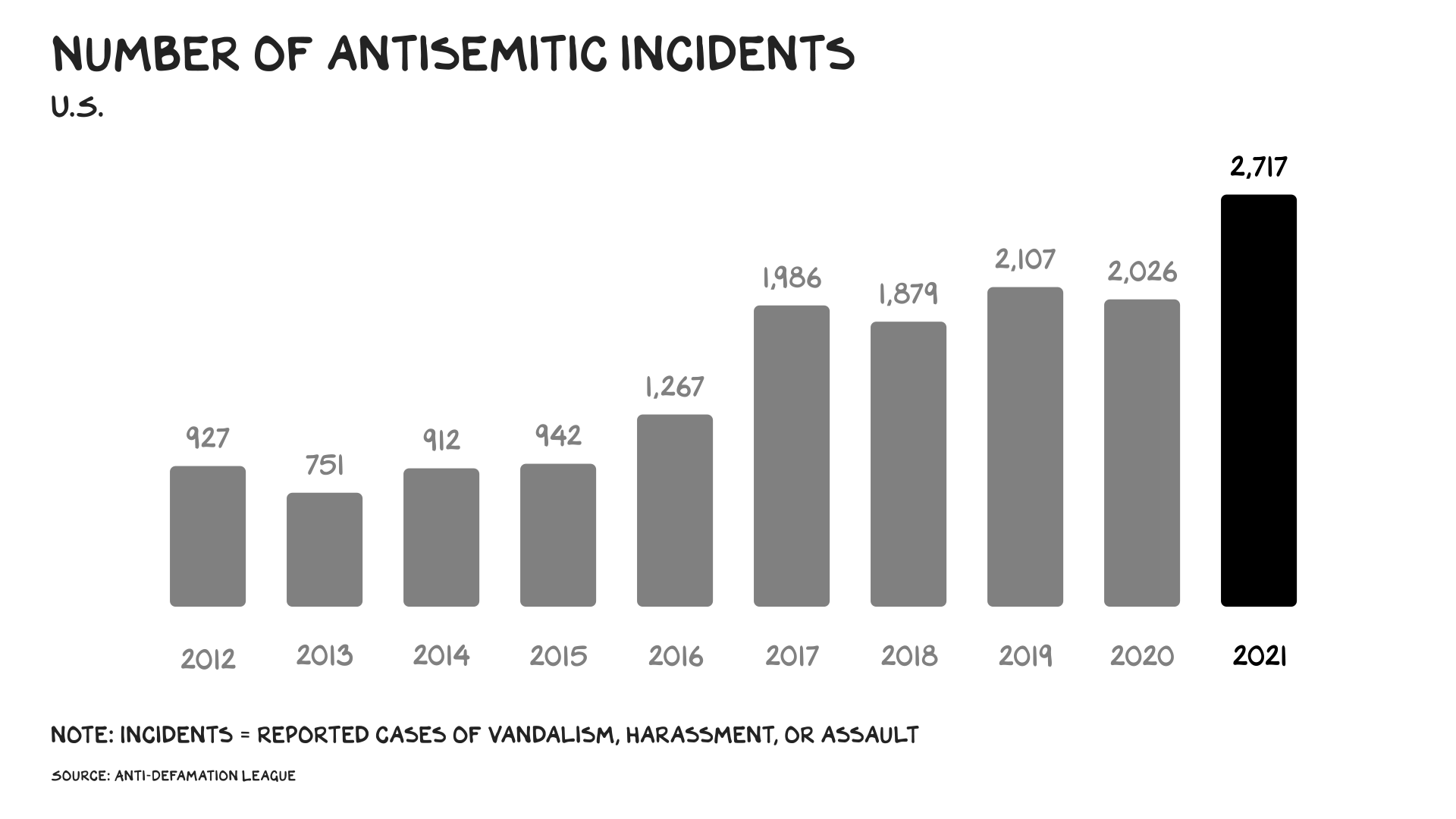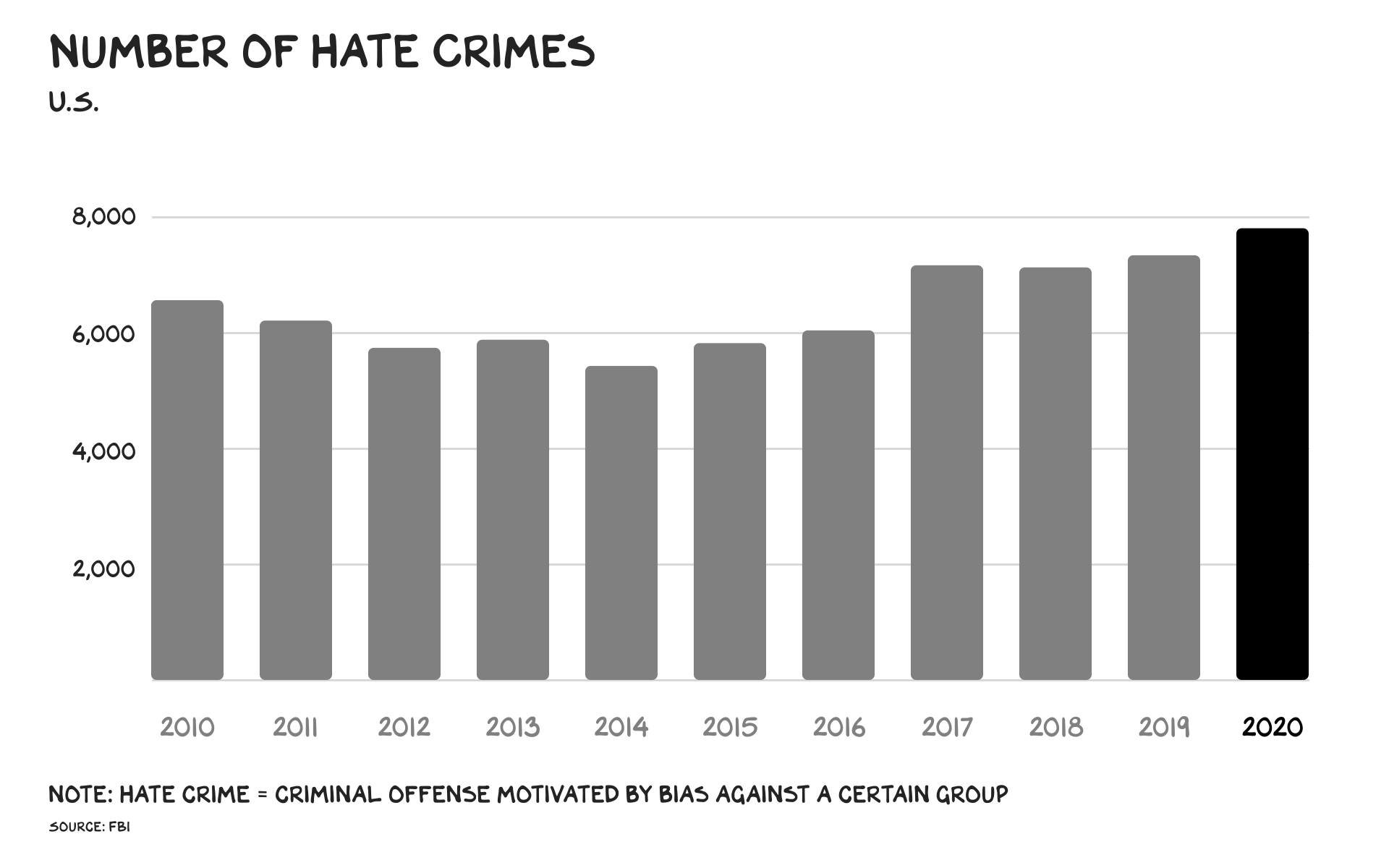The Line
Courtesy of Scott Galloway, No Mercy/No Malice, @profgalloway
-
Listen to This Newsletter
Audio Recording by George Hahn
There was controversy this month involving Kanye West. You can catch up here; I won’t reiterate it. I believe Kanye is ill, and I’ll return to ignoring him soon after this post. This post is about Adidas, Gap, CAA, and his other corporate partners. It is about the moral obligation we have to draw a line.
Familiar Target
Authoritarian power, fascism especially, often rests on the persecution of a group. Fascists ascribe the problems of society to the influence of a minority and argue that controlling or eliminating that group will solve a social ill. The most popular target for this form of social weaponization, for hundreds of years, has been the Jews.
Making up 2% of the U.S. population, and only 0.2% of the world’s population, Jews are, year after year, the target of more anti-religious hate crimes than any group. In the two-year period 2001-02 bookending 9/11 — when Islamic terrorists killed 3,000 people — the FBI identified 636 anti-Islam hate crimes in the U.S., up from just 61 in the two prior years. Over the same period the FBI identified 1,974 anti-Jewish hate crimes — three times as many as directed at Muslims, more than half the religious hate crimes committed during the period.
The anti-Islam number was the anomaly. Year after year, more hate crimes are committed against Jewish Americans than against any other group except Black Americans. (There are six times as many Black Americans, and in total they suffer twice as many hate crimes.) The situation is similar abroad and over time. Persecution of the Jews is so common, there’s a Yiddish word for being massacred: pogrom. QAnon is strange and vile, but likely ends up only a stain on this American era. Antisemitism is history’s most enduring and deadly conspiracy theory.
That’s why special attention should be paid to tropes like “the Jewish media.” The real demon, of course, is demonization, of any target. The history of discrimination and violence against “out” groups is extensive, from the Armenian genocide, to the mass killings of Christians by ISIS, to China’s detainment of Uyghurs, and much, much more. In fact, the Nazis did not limit their attacks to Jews alone. They targeted Romani people, Black people, homosexuals, and the handicapped. Whoever the target, identifying a group, blaming them for society’s problems, and encouraging persecution, including violence, against them is the fascist playbook. We cannot ignore these tactics in the rantings of billionaire celebrities, regardless of what we think of their music, their shoe designs, or their mental health.
A companion tactic is the assertion of victimhood by the fascists themselves. “Replacement theory” is the noxious combination of both, asserting that the persecuted minority will somehow supplant the majority. The rhetoric of fascism is like a battery, drawing energy from contradiction. A self-proclaimed billionaire, for example, wailing about how oppressed he is.
New Normal
We have incorrectly conflated the liberal tradition of “free speech” with neutrality, with protecting the dark shoots of fascism in the name of tolerance. By the time speech has flowered into actions that cannot be ascribed to a “lone wolf” or the “mentally ill,” it has ripened into a movement. Movements are harder to stop, and the cost of resistance becomes so high that good people stop doing and saying the right thing as the understandable instinct for self-preservation kicks in. Later, we find eloquence and grace only in our regret.
I have the feeling that we let our consciences realize too late the need of standing up against something that we knew was wrong. We have therefore had to avenge it, but we did nothing to prevent it. I hope that in the future, we are going to remember that there can be no compromise at any point with the things that we know are wrong.
— Eleanor Roosevelt
Standing up against the rhetoric of hatred has nothing to do with censorship. There is no law forbidding people from employing the rhetoric of oppression, nor should there be. But no principle obligates us to accept them in media or business relationships.
A pillar of state-sponsored horror is the steady normalization of stereotyping and blaming. One person ranting about the Jews or anyone else is readily identified as an outlier and ignored. But as these claims multiply, as they have recently, they seem less outrageous. Political scientist Joseph Overton postulated that at any time there is a range of policies the population deems acceptable, but this “window of discourse” is not constant. It’s become a strategic objective of extremist groups to shift the “Overton window” over time toward their position by using rhetoric and advancing policies just outside the current scope of societal acceptance. And as the volume of hateful rhetoric rises, as research has shown, so too does hate crime.
Normalization Inc.
The rise of fascism — the normalization of hatred — is concomitant with the accommodations of powerful people who register political and financial gain by looking the other way. “Appeasement” is historically associated with Neville Chamberlain, the U.K. Prime Minister who caved to Hitler’s territorial demands rather than risk war with Germany — only to make the eventual war more costly. Chamberlain is unfairly singled out. Much of the British ruling class supported his position, and the U.S. Congress passed law after law barring aid to those threatened by the Nazis until Pearl Harbor made such a position untenable. Accommodation inside Germany began years earlier, with Hitler’s rise to power (via an election) in 1932.
Although Chamberlain is the poster child for appeasement, often the key enablers of fascism are not politicians, but corporations. Large companies benefit from stability, the expansion of their nation’s sphere of influence, and the centralization of power at the expense of the individual — many of the central themes of fascism. It’s no surprise that corporate power is often the handmaiden to authoritarian rule. I write that not as an indictment of corporations — corporations are essential. They are how we organize human effort to accomplish extraordinary things, from electric cars to vaccines. But as corporations become more powerful, their rejection or enablement of hate speech takes on additional importance.
Corporate accommodation of and support for the Nazis is well documented, from Adidas to Volkswagen to Krupp to IG Farben. Multinationals flooded into Pinochet’s Chile as he murdered his political opponents by the thousands. Vladmir Putin’s Russia has made “oligarch” (once simply a term for a member of a ruling clique) into a synonym for business leader. The risk is even greater today, considering the role corporations play in modulating our national discourse. The pure pursuit of profit can lead to dark places. There has to be a line, a moral consideration in place.
Drawing that line can be hard, because the leaders of large companies are culturally inclined toward, if not political neutrality, avoiding political adventurism. Corporations take political positions for business reasons, and 99% of the time, the best position is none. Donate to both sides, lobby for regulatory capture, and then stand on the sidelines.
But neutrality in the face of evil is not neutrality. Amorality is too easily hijacked by the immoral. Hannah Arrendt was fascinated by Adolf Eichmann, the architect of Hitler’s death camp system. He evidently had no ideology of his own, just a “manifest shallowness,” she wrote, “which made it impossible to trace the incontestable evil of his deeds to any deeper level of roots or motives.” If Meta were to change its name again … “Manifest Shallowness” strikes me as a decent fit.
If you are neutral in situations of injustice, you have chosen the side of the oppressor.
— Desmond Tutu
Drawing the Line
Which brings us back to Kanye. And to the corporations that did business with him. Their decision to sever ties is important. Not because they need to “cancel” Kanye. It’s not about Kanye, but drawing a line, arresting the normalization of the demonization of a minority.
In the case of Adidas, the ink for this line will cost shareholders hundreds of millions, if not billions, in shareholder value. The shoe maker has been criticized for waiting 10 days to cut ties. Ten days is an eyeblink in history (and even if management made the decision in 10 minutes, the logistics and legalities of responsibly disentangling a multibillion dollar relationship take time). The company should be commended for its actions.
As expensive as it was, Kanye did Adidas, the corporate world, and maybe America, a favor. As John Oliver put it, “The answer to where you draw the line is literally always ‘somewhere.’” If you never draw one, you forget how. So when someone goes to “death con 3,” society’s writing hand rediscovers penmanship. It helps to practice our cursive so we know we can do it. Drawing a line is a chance to remind yourself, your employees, your shareholders, and your customers that you’d rather take a stand now, when the cost is only profits vs. something much worse.
The Line to Here
In writing and presentations, I often point out that much of my success is due to my circumstances — being born in America, getting a state-sponsored education, etc. But the real roots of my good fortune run even deeper. During the Blitz, my mom was a 4-year-old Jew, sleeping in the London tube. Had the British not drawn a line, and then the Americans and Russians, it’s likely that a 21-mile-wide strip of water would have been breached, and my mother’s life would have ended with a train ride. And someone else would be writing this newsletter.
It should be noted: The allies drew a line against fascism and potential invasion, not antisemitism. The costs would have been less dear had we drawn those lines earlier. The line on Kanye should have been drawn sooner. Every elected leader, citizen, and CEO must ask themselves, Where is my line? To answer the question: We must first decide there is one.
Life is so rich,
![]()
P.S. If you’re a marketing leader, I’m doing a free, exclusive Q&A for you on Nov. 10 from 1 to 2 p.m. ET. We’ll discuss marketing in the current environment, the challenges you’re facing, and anything else on your mind. You can apply to attend here.



